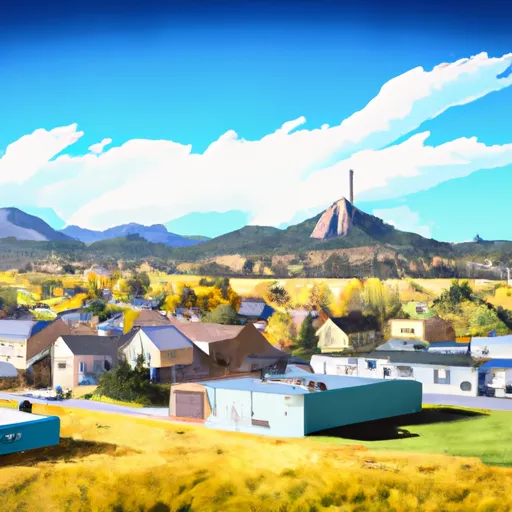-
 Snoflo Premium
Snoflo Premium
Get unlimited access to all our content
With no Ad interruptions! - Start Your Free Trial Login with existing account
Rollinsville
Eden Index
Climate
6.9
•
Recreation
9.3
•
Community
1.5
•
Safeguard
6.4/10

Rollinsville, located in Gilpin County, Colorado, is a small mountain town situated at an elevation of 8,474 feet. The climate in Rollinsville is characterized by cool summers and cold winters. The average high temperature in summer ranges from the mid-60s to low 70s Fahrenheit, while winter temperatures can drop below freezing, with average highs in the 30s. Snowfall is common in the winter months.
Rollinsville is nestled in the Rocky Mountains, surrounded by stunning natural beauty. The area is known for its abundant hydrology constituents, including pristine rivers, lakes, and streams. Outdoor enthusiasts can enjoy various activities such as fishing, kayaking, and paddleboarding in nearby water bodies like South Boulder Creek and Gross Reservoir.
Apart from water-related recreation, Rollinsville offers ample opportunities for hiking and camping. Several hiking trails wind through the scenic mountains, providing breathtaking views and a chance to explore the local flora and fauna. The nearby James Peak Wilderness area is a popular destination for backpacking and wildlife sightings.
With its idyllic mountain setting and a range of outdoor recreation options, Rollinsville is a paradise for nature lovers and adventure seekers.
What is the Eden Index?
The Snoflo Eden Index serves as a comprehensive rating system for regions, evaluating their desirability through a holistic assessment of climate health, outdoor recreation opportunities, and natural disaster risk, acknowledging the profound impact of these factors on livability and well-being.
Climate Health Indicator (CHI): 6.9
Rollinsville receives approximately
715mm of rain per year,
with humidity levels near 50%
and air temperatures averaging around
4°C.
Rollinsville has a plant hardyness factor of
5, meaning
plants and agriculture in this region thrive during a short period during spring and early summer. Most
plants will die off during the colder winter months.
By considering the ideal temperature range, reliable water supplies, clean air, and stable seasonal rain or snowpacks, the Climate Health Indicator (CHI) underscores the significance of a healthy climate as the foundation for quality living.
A healthy climate is paramount for ensuring a high quality of life and livability in a region, fostering both physical well-being and environmental harmony. This can be characterized by ideal temperatures, reliable access to water supplies, clean air, and consistent seasonal rain or snowpacks.
Weather Forecast
Streamflow Conditions
South Platte
Area Rivers
South Platte
Snowpack Depths
South Platte
Reservoir Storage Capacity
South Platte
Groundwater Levels
Recreational Opportunity Index (ROI): 9.3
The Recreational Opportunity Index (ROI) recognizes the value of outdoor recreational options, such as parks, hiking trails, camping sites, and fishing spots, while acknowledging that climate plays a pivotal role in ensuring the comfort and consistency of these experiences.
Access to outdoor recreational opportunities, encompassing activities such as parks, hiking, camping, and fishing, is crucial for overall well-being, and the climate plays a pivotal role in enabling and enhancing these experiences, ensuring that individuals can engage in nature-based activities comfortably and consistently.
Camping Areas
| Campground | Campsites | Reservations | Toilets | Showers | Elevation |
|---|---|---|---|---|---|
| Twin Eagles | 9 | 8,547 ft | |||
| Meridian | 18 | 9,013 ft | |||
| Green Mountain | 6 | 7,615 ft | |||
| Lost Park | 12 | 9,958 ft | |||
| Burning Bear | 13 | 9,643 ft | |||
| Goose Creek | 10 | 7,701 ft | |||
| Whiteside | 5 | 8,909 ft | |||
| Spruce Grove - Lake George | 27 | 8,510 ft | |||
| Kenosha Pass | 25 | 10,052 ft | |||
| Deer Creek | 13 | 9,092 ft |
Nearby Ski Areas
Catastrophe Safeguard Index (CSI):
The Catastrophe Safeguard Index (CSI) recognizes that natural disaster risk, encompassing floods, fires, hurricanes, and tornadoes, can drastically affect safety and the overall appeal of an area.
The level of natural disaster risk in a region significantly affects safety and the overall livability, with climate change amplifying these risks by potentially increasing the frequency and intensity of events like floods, fires, hurricanes, and tornadoes, thereby posing substantial challenges to community resilience and well-being.
Community Resilience Indicator (CRI): 1.5
The Community Resilience Indicator (CRI) recognizes that education, healthcare, and socioeconomics are crucial to the well-being of a region. The CRI acknowledges the profound impact of these elements on residents' overall quality of life. By evaluating educational resources, healthcare accessibility, and economic inclusivity, the index captures the essential aspects that contribute to a thriving community, fostering resident satisfaction, equity, and social cohesion.

